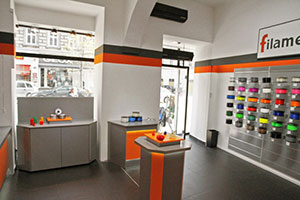Finally, 3D printing for consumers is getting everywhere!
Last year around this time, Rachel predicted the growth of brick-n-mortar 3D printing stores, both 3D printer retailers and 3D printing service bureaux. In her mind, physical hubs for 3D printing presented the next logical step in the consumer 3D printing market. As she pointed out, MakerFaires and Trade Shows are good for ensnaring hobbyists/Makers who are already keen to learn about new technology, but physical stores make for good strategy when it comes to hailing average consumers. All that the uninitiated need to become believers of the technology’s potential is to see it in action. A year has passed and, I’d say, she was right.

Established, non-industry companies have also brought 3D printing to consumers with both 3D printer retail and services. Microsoft has begun selling MakerBot Replicator 2 machines at 41 of their retail stores across the United States and the 3D Systems’ Cube will be sold at Dixons, PC World and Currys in the UK. A variety of well-known chains have announced that they will be providing in-store 3D printing services, a list that includes the UPS Store, the Walmart-owned Asda supermarkets in York, UK, and possibly Tesco, also in the UK.
I don’t mean to give you a list of every instance of physical 3D printing locations that have emerged since Rachel’s initial report. Trust me, the examples I’ve listed could go on and on. The point is, to me, that 3D printing, despite initial criticism on the part of some analysts that the technology is still too underdeveloped, is at a point in which it will quickly be adopted by consumers, if it hasn’t already. As Scott Dunham of Photizo Group said, echoing Rachel’s sentiments, “physical retail sales channels hold the benefits of exposing potential customers directly to the technology. If the rash of new 3D printing ‘experience’ stores tell us anything, it’s that people who see 3D printers in action are captivated by them.” People simply needed to see the machines in action, producing really cool (if not always perfect and polished) stuff in order to become excited. The technology may not have fully matured, but it’s already decent enough to catch on.
3D printing has become a meme, a concept so intrinsically exciting that it was natural for the zeitgeist to swallow it whole and disperse it among its various channels. The technology is a symbol of humanity’s ultimate desire to, basically, do anything and reach its fullest potential. In its most evolved form, 3D printing would allow users to fabricate anything imaginable (and unimaginable), a genie’s lamp with unlimited wishes. And, so, it attracts media attention easily, lends itself to countless copy-cats and original pioneers who create their own printer lines, retail stores, service bureaux and everything in-between.
So, when someone is first introduced to the technology in person, there might be a part of them that is disappointed that 3D printers can’t do everything, but there is also a part of them that can’t help but be blown away anyway because they know that there’s something they can achieve with this machine, even if they can’t think of it yet. Rachel was quite right in saying that “Ironically, Internet shopping is a vast growth area for many high street chains that are seeing footfall from consumers fall away in their stores, but for consumers of 3D printing I actually think it needs to work the other way around.” This is because, with 3D printing, you have to see it to believe it. And, once you do, there’s no turning back.


